Xerox PARC Model - Tabs, Pads and Boards
Books - The Personal Computer Survives
The Cloud & Collaborative Computing
Written By: Adam
Rosen
15 March 2010
The launch of the Apple iPad, and the surrounding hype and simultaneous
debunking of its supernatural abilities, has been hard to ignore. Initially
perceived as another device which will revolutionize the world, it has
already been second-guessed and panned by many people as too little
for too much, and as of this writing it hasn't even shipped yet! Every
week several of my consulting clients ask me what I think of the device,
and will it be successful. Now that's good brand management!
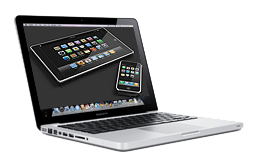 Short
answer: yes I think it will be successful, and will find several strong
market areas. However this success will be evolutionary, just as the
iPod's was. The first generation iPad actually does more than I expected
for the price, which is notable for an Apple product. But I think what's
more significant is what the iPad represents in the history and spectrum
of computing technology.
Short
answer: yes I think it will be successful, and will find several strong
market areas. However this success will be evolutionary, just as the
iPod's was. The first generation iPad actually does more than I expected
for the price, which is notable for an Apple product. But I think what's
more significant is what the iPad represents in the history and spectrum
of computing technology.
The
iPad launch got me thinking about an old paper I'd once read about "Tabs,
Pads, and Boards" and how small portable computers with different
form factors were the direction technology was taking. Upon further
review it's amazing how well this model has held up over time. The paper
was written - where else - at the famous Xerox PARC research facility,
birthplace of the GUI, the mouse, and much of modern computing.
Xerox PARC Model - Tabs, Pads, and Boards
In
1991 Mark Weiser of Xerox PARC wrote an article for Scientific
American magazine entitled The
Computer for the 21st Century, describing an envisioned
concept called Ubiquitous Computing:
“Ubiquitous computing names the third wave in computing, just
now beginning. First were mainframes, each shared by lots of people.
Now we are in the personal computing era, person and machine staring
uneasily at each other across the desktop. Next comes ubiquitous computing,
or the age of calm technology, when technology recedes into the background
of our lives.”
More
specifically:
"Ubiquitous
computers will also come in different sizes, each suited to a particular
task. My colleagues and I have built what we call tabs, pads and boards:
inch-scale machines that approximate active Post-It notes, foot-scale
ones that behave something like a sheet of paper (or a book or a magazine),
and yard-scale displays that are the equivalent of a blackboard or
bulletin board."
This
concept of small, portable computing devices - ubicomp - resonated with
me, and I filed the information away for future reference. At the time
Apple was transitioning from 68k to PowerPC based Macs and dialup modems
reigned supreme. But in the ensuing two decades technology marched on
and this vision has begun to take shape in reality.
Tabs
In
the article, Weiser wrote:
"Tabs are the smallest components of embodied virtuality. Because
they are interconnected, tabs will expand on the usefulness of existing
inch-scale computers such as the pocket calculator and the pocket
organizer. Tabs will also take on functions that no computer performs
today. For example [...] badges can identify themselves to receivers
placed throughout a building, thus making it possible to keep track
of the people or objects to which they are attached."
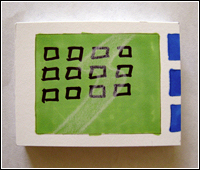 PARC
Prototype Tab
PARC
Prototype Tab |
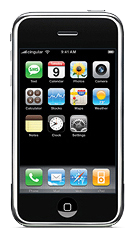 |
The
Tab has evolved via the convergence of the PDA, the cell phone, the
RFID badge and other discreet devices into today's small handheld computers
- more commonly called smartphones. The smartphone is personal, portable,
stores data, interacts with "the cloud", reports on locations,
etc.. The Treo, Blackberry and Windows Mobile devices all crossed
this threshold earlier in the decade, with the Apple iPhone
(the Prodigal Son of Tabs) then following with major user interface
improvements and an application development environment that have transformed
the industry.
The
iPhone (and smartphones in general) are at an exciting point in their
development; we're past the initial "isn't this cool" stage
and are developing new unforeseen applications upon which we rely daily.
The Tab has arrived, and is in fact entrenched.
Pads
Weiser
continued:
"The next step up in size is the pad, something of a cross between
a sheet of paper and current laptop and palmtop computers. [...] Pads
differ from conventional portable computers in one crucial way. Whereas
portable computers go everywhere with their owners, the pad that must
be carried from place to place is a failure. Pads are intended to
be "scrap computers" (analogous to scrap paper) that can
be grabbed and used anywhere; they have no individualized identity
or importance."
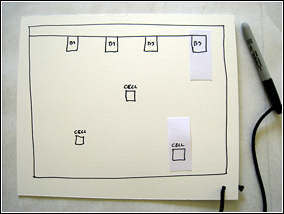 PARC
Prototype Pad
PARC
Prototype Pad |
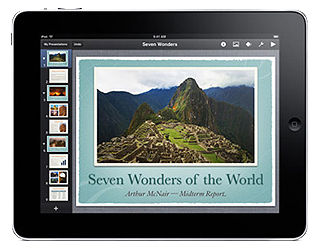 |
Pads,
or their more common term, tablet computers, have been around serving
niche markets for over a decade but have struggled to find an identity.
Most have been pen-based devices (also envisioned by Xerox), with touch
screens becoming more popular as the technology has improved. The price
point has not made them "scrap computers" and many are carried
from place to place, but the concept of a more limited shared network
resource, instead of a portable personal computer, is clear.
The
Apple iPad marks the clearest emergence yet of the
Pad as a component of ubiquitous computing - a cross between a full
computer and a handheld smartphone, with a user interface already familiar
to users of both devices. Among the hype and discussion about this new
device I can already see several areas where this could be a very useful
form factor; for example:
-a
multimedia, internet enabled textbook reader (no stack of books to
carry, complete your assignments online)
-a portal to online news and entertainment content, with a very readable
screen size (unlike smartphones)
-a medical imaging playback device, enabling doctors and medical staff
to access scans wherever needed
The
Pad is not yet entrenched but may well soon be - over 50
devices in this form factor are planned for launch this
year!
Boards
The
final device is wall sized:
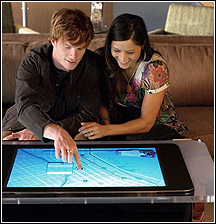 "Yard-size
displays (boards) serve a number of purposes: in the home, video screens
and bulletin boards; in the office, bulletin boards, whiteboards or
flip charts. A board might also serve as an electronic bookcase from
which one might download texts to a pad or tab. For the time being,
however, the ability to pull out a book and place it comfortably on
one's lap remains one of the many attractions of paper."
"Yard-size
displays (boards) serve a number of purposes: in the home, video screens
and bulletin boards; in the office, bulletin boards, whiteboards or
flip charts. A board might also serve as an electronic bookcase from
which one might download texts to a pad or tab. For the time being,
however, the ability to pull out a book and place it comfortably on
one's lap remains one of the many attractions of paper."
Boards
are just beginning to appear on the scene; the Microsoft Table
is probably the best current example. More limited versions of this
technology, such as sharing your screen on a wall display or projector,
or smart walls which can download data to devices over the network,
already exist. Yet these are not fully collaborative devices so much
as large scale input and output peripherals for computers.
That
the Board has not evolved to the extent the Tab and the Pad have is
likely due to several reasons. One is technological, we're just now
reaching the point where smart network devices are practical and affordable.
But the other I believe is due more to a shift in how we've chosen to
use existing technology and the concept of "cloud computing"
itself.
Books - The Personal Computer Survives
In
the Xerox model the desktop (personal) computer gets superceded by Tabs,
Pads and Boards. There's no need to have lots of expensive CPU power
on your desk when the network can do it for you. However in practice
the personal computer has not gone away.
Many
of us still want full keyboards, screens, peripherals, expansion slots,
etc. and the associated flexibility and expansion capability
this enables. Also the initial promise of cloud computing as a complete
substitute for local storage and processing has not fully proven out,
though this is steadily gaining in popularity (see below).
What
has happened is that the form factor has changed, with laptops
or portable computers becoming more popular than desktop computers in
the past decade. Today many people carry laptops and connect them in
their homes or offices to a larger screen and keyboard on their desks
- a small Board on which to access their data.
The
technology industry is often in a rush to redesign form factors in order
to create a new product to sell, but sometimes the tried and true solution
is better. A tactile physical keyboard is a better writing tool than
a touch screen, no matter how you jazz things up.
If
the personal computer doesn't go away, we need to give it a place in
the Ubiquitous Computing model. In tribute to years of naming trends
- notebook, netbook, PowerBook, MacBook, etc. - I suggest we
can call the portable computer the Book in the spectrum
of computing devices: a pinnacle of self contained knowledge, portable,
with easy networking capability.
The Cloud & Collaborative Computing
If
the Board is viewed conceptually as a space for collaborative computing,
rather than a physical device, I think the PARC model still holds true.
The networking requirements were described in Weiser's paper as a key
component for Ubiquitous Computing to work:
"Prototype tabs, pads and boards are just the beginning of ubiquitous
computing. The real power of the concept comes not from any one of
these devices; it emerges from the interaction of all of them. The
hundreds of processors and displays are not a "user interface"
like a mouse and windows, just a pleasant and effective "place"
to get things done."
At
that time however there was no way to make everything talk to each other:
 "Present
technologies would require a mobile device to have three different
network connections: tiny range wireless, long range wireless, and
very high speed wired. A single kind of network connection that can
somehow serve all three functions has yet to be invented."
"Present
technologies would require a mobile device to have three different
network connections: tiny range wireless, long range wireless, and
very high speed wired. A single kind of network connection that can
somehow serve all three functions has yet to be invented."
That
network exists today, through a combination of wired ethernet, WiFi,
bluetooth and digital cellular components bridged using the TCP/IP protocol.
When data is stored and shared online we describe this as being in the
Cloud and have the ability to access the data from
multiple locations simultaneously. We can collaborate with others on
our work through such "cloud computing".
The
last several decades have seen various expressions of collaborative
workspaces: Lotus Notes, Microsoft Exchange, Google Office, various
Content Management Systems, etc.. We're already working together,
but remotely, rather than inside a shared physical space.
My
thesis in a nutshell: Collaborative Computing, facilitated though the
use of the Cloud, and interfaced via Tabs, Pads and Books, is the ultimate
expression of the Board as Ubiquitous Workspace. As Sun used to say
in it's ads, "the network is the computer"
Apple's Convergent Position
Apple is uniquely positioned to continue surfing this growing wave -
as they should be. The company has consistently built on the work done
at Xerox PARC since the launch of the Lisa, and many of PARC's engineers
have gone on to work for Apple. The iPhone, iPod Touch, iPad, Macintosh
and AppleTV devices all target different interfaces in the ubiquitous
computing continuum, but share one important similarity - they all
run OS X.
The Macintosh clearly runs OS X, as Mac OS X. The iPhone, iPod Touch,
and the iPad run the "iPhone OS" which is just a visual variant
(GUI, or shell) on top of OS X for these devices. The core operating
system is the same. This is also true with the AppleTV, which runs OS
X at heart and talks to the displays in your living room. Now we have
a common OS, with multiple user interfaces, scalable to different devices
with differing resolutions, applied across a common network (the internet
via your local LAN).
Interesting convergent position Apple now finds themselves in - and
one that's not coincidental. In this broad model the iPad and AppleTV
begin to make sense as pieces of a computing spectrum, rather than be-all
products themselves. I'm excited for the ride to come!
This article was also published in the Adam's
Apple column on Low End
Mac